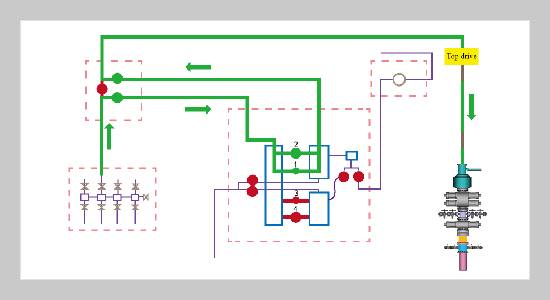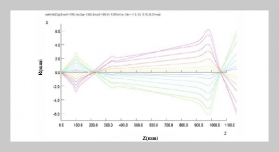Geng Hao1,2, Xiong Qingshan1,2This email address is being protected from spambots. You need JavaScript enabled to view it., Cui Shuqing3, Liuyu1,2, Shi Fang1,2, Kamgue Lenwoue Arnaud Regis1,2, Wang Ke1,2, Shou Xiang4
1School of petroleum engineering, Yangtze University, Wuhan 430100, China
2School of Petroleum Engineering, Yangtze University: National Engineering Research. Center for Oil & Gas Drilling and Completion Technology. Wuhan 430100, China
3Petroleum China Huabei Oilfield Company. Cangzhou 062550, China
4Chengdu Best Diamond Drill Bit Co. LTD. Chengdu 610000, China
- [1] Q. Guan, (2019) “Difficulties in Drilling Risks of High Temperature and High Pressure Horizontal Wells and Countermeasures" China Resources Comprehensive Utilization 37(78-80): DOI: 10.3969/j.issn.1008-9500.2019.02.023.
- [2] M. Luo, Y. Feng, Y. Gui, D. Jingen, and C. Han, (2021) “Development status and prospect of key technologies for high temperature and high pressure drilling" Petroleum Science Bulletin 2: 228–244. DOI: 10.3969/j.issn.2096-1693.2021.02.018.
- [3] P. Vieira, F. Torres, R. Qamar, and G. Marin. “Downhole pressure uncertainties related to deep wells drilling are safely and precisely ascertained using automated MPD technology”. In: North Africa Technical Conference and Exhibition. OnePetro. 2012.
- [4] A. Al Mutawa, I. Hamdy, E. D. Al Shamisi, B. El Yossef, M. S. Amin, Y. Nunez, M. Saleh, and A. HadjMoussa. “Managed Pressure Drilling and Underbalanced Drilling Compounded Role in Solving the Exploration and Appraisal Challenges of Biogenetic Gas Resources in the United Arab Emirates-Case Study”. In: Abu Dhabi International Petroleum Exhibition and Conference. SPE. 2021, D021S057R003.
- [5] R. Lovorn, A. McLennan, B. Grayson, and I. Poletzky. “Optimizing The Drilling Process When Using MPD Techniques In Deep Water Applications”. In: Offshore Technology Conference. OTC. 2020, D021S020R002.
- [6] R. Verma, V. Muthamizhvendan, S. Ganesan, M. Sarode, M. Syafiq, A. Diware, and A. Berry. “Case Study: First Ever Implementation of Managed Pressure Drilling to Drill Exploratory and Near Wildcat Well at Ongc Tripura Asset”. In: International Petroleum Technology Conference. IPTC. 2022, D022S144R002.
- [7] Z. Kazakbayeva, A. Kaidarov, A. Magda, F. Aliyev, H. Patil, E. Dietrich, and I. Cook. “Successful implementation of managed pressure drilling and managed pressure cementing techniques in fractured carbonate formation prone to total lost circulation in Far North Region”. In: SPE Eastern Europe Subsurface Conference. SPE. 2021, D011S004R001.
- [8] F. Colaianni. “Continuous Circulation Drilling, MPD: Adding Value Through Safety Enhancements and Cost Control.” In: International Petroleum Technology Conference. IPTC. 2020, D033S208R001.
- [9] S. W. Petrie and R. Doll. “Benefits of Using Continuous Circulation Systems in ERD Wells to Manage ECD, Bottom Hole Pressure and Hole Cleaning”. In: SPE/IADC Middle East Drilling Technology Conference and Exhibition. SPE. 2021, D031S015R002.
- [10] R. Ashena, A. Elmgerbi, V. Rasouli, A. Ghalambor, M. Rabiei, and A. Bahrami, (2020) “Severe wellbore instability in a complex lithology formation necessitating casing while drilling and continuous circulation system" Journal of Petroleum Exploration and Production Technology 10: 1511–1532. DOI: 10.1007/s13202-020-00834-3.
- [11] J. J. Arellano, J. E. Pozzo Huerta, R. Johnson, I. Poletzky, and B. Kumar. “Case Study: Implementing Continuous Circulation and Managed Pressure Drilling Techniques to Drill in the Challenging Perla Gas Field in Offshore Venezuela”. In: SPE Latin America and Caribbean Petroleum Engineering Conference. SPE. 2020, D022S004R003.
- [12] Z. Li, R. Xie, and J. Yuan, (2020) “Study on the drilling safety probability interval in narrow pressure window formation in deepwater HPHT gas fields" Natural Gas Industry 40(12): DOI: 10.3787/j.issn.1000-0976.2020.12.010.
- [13] X. Yang, Y. Zhou, S. Fang, and K. Wang, (2010) “Strategy Analysis of Narrow Window Drilling Technology and Practice" Oil Field Equipment 39(7-11): DOI: 10.3969/j.issn.1001-3482.2010.08.002.
- [14] G. Zhang, L. Jun, L. Gonghui, W. Jiangshuai, Z. Ruiyao, and C. Wang, (2021) “A Precise Model for Prediction of Annular ECD in Offshore HTHP Wells" Drilling Fluid and Completion Fluid 38(6): 698–704. DOI: 10.12358/j.issn.1001-5620.2021.06.006.
- [15] Y. Zhou, M. Cui, and Y. Cha, (2008) “Discussion and Prospect of Managed Pressure Drilling Technology" Petroleum Drilling Techniques 36(4): 1–4. DOI: 10.3969/j.issn.1001-0890.2008.04.001.
- [16] G. Wang, H. Fan, G. Liu, P. Gong, Y. Li, and C. Shi, (2009) “Application of Managed Pressure Drilling Techniques" Petroleum Drilling Techniques 37(1): 34–38. DOI: 10.3969/j.issn.1001-0890.2009.01.008.
- [17] M. Yang, Y. Meng, G. Li, Y. Li, and H. Jia, (2009) “Effective Means to Improve Penetration Rate in Deep Well" Oil Field Equipment 38(8): 6–8. DOI: 10.3969/j.issn.1001-3482.2009.08.002.
- [18] M. Luo, Y. Feng, Y. Gui, J. Deng, and C. Han, (2021) “Development status and prospect of key technologies for high temperature and high pressure drilling" Petroleum Science Bulletin 6(228-244): DOI: 10.3969/j.issn.2096- 1693.2021.02.018.
- [19] G. Li, Z. Huang, and J. Li, (2017) “Study of the Key Techniques in Radial Jet Drilling" Petroleum Drilling Techniques 45(2): 1–9. DOI: 10.11911/syztjs.201702001.
- [20] Z. Du, Z. Guan, and X. Song, (2001) “Hydraulic parameter design and calculation method in extended reach well" Petroleum Drilling Techniques 29(4): 12–13. DOI: 10.3969/j.issn.1001-0890.2001.04.003.
- [21] H. Yang and J. Yan, (2003) “Determination And Control Of The Density Of Drilling Fluids During Underbalanced Drilling" Oil Drilling & Production Technology 25(6): 5–9. DOI: 10.3969/j.issn.1000-7393.2003.06.002.
- [22] Y. Gao, B. Sun, Z. Wang, S. Cao, L. Song, and H. Cheng, (2008) “Calculation and analysis of wellbore temperature field in deepwater drilling" Journal of China University of Petroleum (Edition of Natural Science) 32(2): 58–62. DOI: 10.3321/j.issn:1673-5005.2008.02.012.
- [23] Y. Qiu, D. Yang, Q. Liu, C. Han, and L. Mo, (2009) “Development and Field Tests of Foreign Continuous Circulation System" Petroleum Drilling Techniques 37(2): 100–102. DOI: 10.3969/j.issn.1001-0890.2009.02.026.
- [24] Q. Ma, (2008) “Continuous Circulation System" China Petroleum Machinery 36(9): 210–212. DOI: 10.16082/j.cnki.issn.1001-4578.2008.09.054.
- [25] Z. Hu, Q. Ma, Q. Shao, and B. Liu, (2011) “Development and investigation of continuous circulation drilling." Oil Drilling & Production Technology 33(1): 1–6. DOI: 10.13639/j.odpt.2011.01.002.
- [26] C. Li, D. He, Y. Xie, C. Yile, et al., (2011) “Design of a novel continuous circulation valve. Drilling & Production Technology" Drilling & Production Technology 34(2): 64. DOI: 10.3969/j.issn.1006-768X.2011.02.020.
- [27] R. Qin, L. Wang, H. Chen, H. Guolei, and B. Xu, (2021) “Drilling fluid continuous circulation drilling technology and automatic equipment design" Exploration Engineering Media (6): 63–67. DOI: 10.12143/j.ztgc.2021.06.010.
















